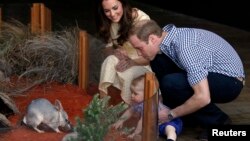The world’s largest cat-proof fence has been completed in central Australia. The mammoth project creates a 94-square-kilometer sanctuary for endangered marsupials.
The 44-kilometer-long fence surrounds the largest cat-free area on mainland Australia. It creates a haven for native animals that have been devastated by feral cats, northwest of Alice Springs.
It is not only the world’s largest cat-proof fence but also part of the most extensive feral cat eradication program anywhere.
Predators out, marsupials in
The plan is to use Aboriginal rangers to remove all feral pests from the large enclosure by the end of this year and then re-introduce threatened marsupials, including the rufous hare-wallaby, the bilby and golden bandicoot.
Josef Schofield from the Australian Wildlife Conservancy, which owns the site, says it will give vulnerable native species the chance to thrive once again.
“The project is a threatened species reintroduction project,” he said. “We are aiming at eradicating feral animals, predators particularly — cats and foxes — from a large landscape. We will be working with local Indigenous communities to achieve that eradication. We will be then reintroducing a whole range of Australian endangered mammal species that have disappeared from this landscape completely.”
High extinction rate
Cats and foxes are one of the main reasons Australia has the worst mammal extinction rate in the world.
It is estimated that feral cats kill 1 million birds in Australia every day and have caused the extinction of 20 native species.
Fences to repel rabbits and wild dogs have been built in other parts of the country.
Australia has a terrible history of importing animals, plants and fish that have caused immense ecological damage.
In 1935, about 100 cane toads were brought in from Hawaii to help sugar cane farmers combat a destructive beetle. Some estimates put the current cane toad population in Australia at 200 million. Their powerful toxins have killed huge numbers of native animals.
Australia also has large numbers of feral camels, pigs, rabbits, goats and water buffaloes.








